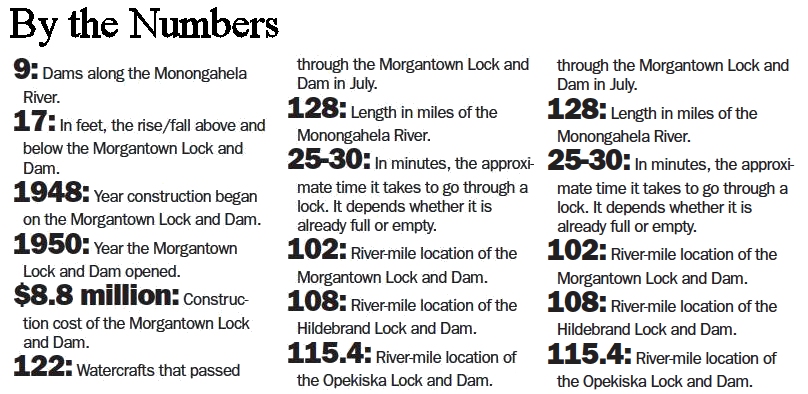The Monongahela River Lock-and-Dam System
Morgantown Dominion Post
28 August 2011
By Amanda DeProspero
The water level difference on each side of the Morgantown Lock and Dam
is 17 feet. The only way to navigate the Monongahela River around the
dam is through the lock system.
There’s no reason to lock yourself in to only one section of the
Monongahela River.
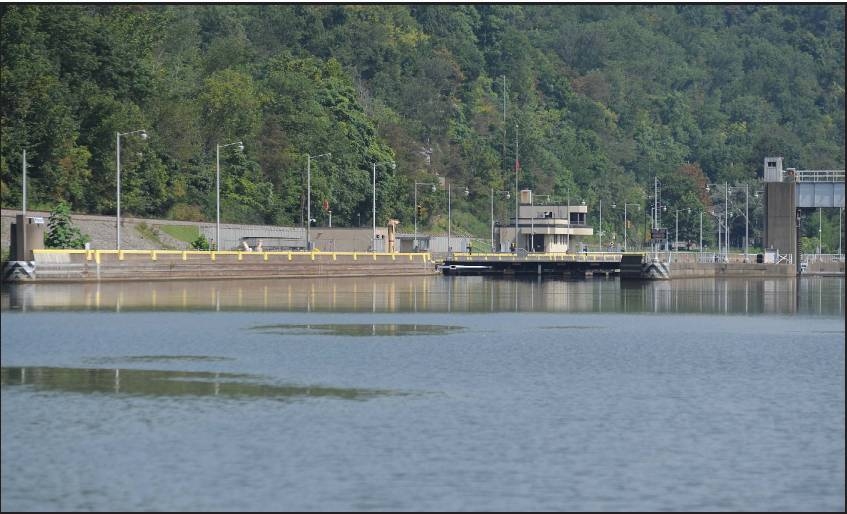
Approaching Morgantown Lock from up stream.
In fact, with a little knowhow, any boater is free to explore the 128
miles of the Mon by passing through its locks and dams during their
hours of operation.
Sometimes, though, just the thought of attempting to do this can be a
little intimidating, especially for newbies, said Jeff Helmick, lock
operator at the Morgantown Lock and Dam.
One of the most common misconceptions, he said, is that people believe
there’s a cost to pass through.
“People are afraid,” he said. “They don’t know what it costs. It’s
free.”
Others may think it’s too complicated, he said, or that the lock
operator is being put out in some way by helping a boater through the
locks. But that’s untrue as well, he said, adding that he will talk to
the people passing through and make sure they’re doing OK with the
process.
It’s for these reasons that he wants to fill everyone in on a little
secret: With an understanding of the basic rules and safety
regulations, any boater can pass through the locks with no problem.
And here’s how you do it.
A trip through the locks
On a recent Saturday, Tim Terman, captain of the Monongahela
Monitor, his pontoon boat, demonstrates how to safely take a craft
through the locks.
Starting in the docks beside The Wharf restaurant, Terman maneuvers the
boat slowly up to the right side of the Morgantown Lock and Dam within
range of a ladder on the far end of the long wall. There’s a thick rope
hanging on this ladder that, when pulled, sounds a horn to alert the
lock operator that a boat would like to pass through. After a couple
short blasts, Terman relaxes back in his captain’s chair to wait for
the wide, double doors to open.
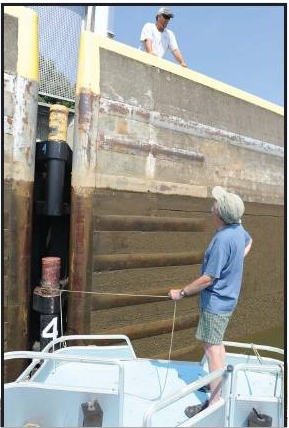
Tim Terman talks to Lock Operator Jeff Helmick as he
tends a line and the water level changes.
Pointing to the top of the dam where a little dribble of water
indicates that the container is full of water, Terman explains that
calling the lock operator ahead of time is a good idea because it gives
him time to ready thelock — whetherby emptying the water or filling it
— for the boater.
As he waits, it’s clear by the water coming out the emptying valves
that the lock operator has heard the horn.
A light flashes red, alerting boaters not to move into the main channel
yet. There’s also a sign on the opposite wall that tells boaters not to
be within 300 feet of the water emptying valves.
“One time I got too close and [the lock operator] told me to get back,”
Terman said, adding that the amount of water rushing out of the valves
could cause big problems for a small boat.
“When it discharges, it could capsize a boat,” Helmick said.
When the water is finally emptied, the large doors begin opening, but
since there’s still no signal to move from the lock operator, Terman
continues to wait.
Finally there’s a loud whistle and the light turns to green. On low
speed, Terman steers the boat into the lock, carefully avoiding the
sticks that have floated into the passageway. He then proceeds almost
all the way up to the end of the chamber, where there is a place to tie
up on the land-side of the dam.
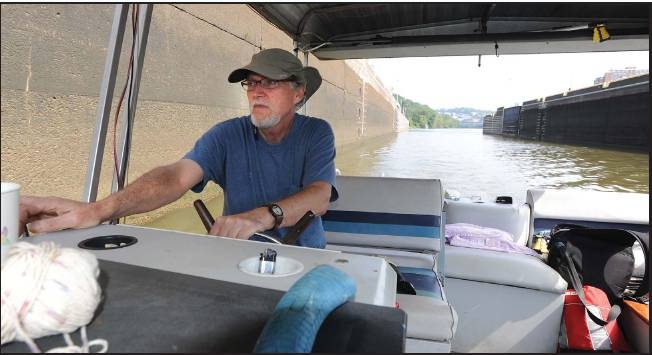
Entering the lock chamber at the lower level..
“Good morning,” Terman yells up to Helmick, who is waiting until
the boat gets settled to open the filling valves that will add water to
the chamber.
“We’re just going to go up a little ways and come back,” Terman says
gesturing to the upper side of the river.
Terman then turns the engine off on his boat. “You don’t have to, but
why run up the fuel?” he says.
As the water begins to fill the chamber from the middle, the boat
slowly rises with the water level. Terman has attached the rope to what
steam boat crews call “floating timberheads.” These timberheads also
rise with the water level so boaters don’t have to adjust the rope.

Tim Terman talks to Lock Operator Jeff Helmick at
the upper water level.
Before long, the water has risen 17 feet. As the doors open, the
lock operator gives the horn another blast, alerting the boater to
leave the chamber and enter the next section of the Mon River.
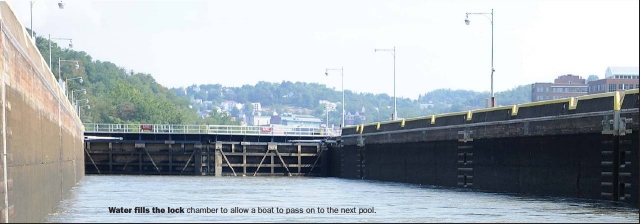
Inside the lock chamber.
What you need and safety
For those who’ve never locked through before, Helmick said there
are a few items you shouldn’t forget. He said a life jacket is a good
idea, as well as a rope that is at least 20 feet long so you can tie up
inside the lock chamber.
Terman also said having an extendable pole on board is handy to help
you grab the string outside the dam that alerts the lock operator.
As far as safety goes, Helmick said to be wary of the double doors and
the emptying valve before entering the lock chamber, and leave a good
amount of space in front of you so the boat doesn’t capsize.
Terman said other boats could be leaving the locks as you are trying to
get in, so be sure to leave room for any other vessels to depart as the
doors open.
Once inside the lock, there is no smoking, Helmick said.
Remain seated as the water rises, and don’t leave the chamber until the
lock operator signals you to.
It is possible for multiple boats to lock through at the same time,
Helmick said.
“We’ve had times when 20 or 30 boats go through at the same time,” he
said. In that case, those boats were able to secure themselves in the
chamber by tying up to each other.
If there are any questions about the process, Helmick said he can speak
to boaters while they’re inside the chamber, so he can walk them
through it.
Locking Steps
STEP 1: Use a phone to call or pull the string outside the dam to
alert the lock operator that you would like to pass through.
STEP 2: Stay where you are and wait until the stoplight turns to green
and the whistle sounds betore slowly entering the lock chamber.
STEP 3: Proceed almost to the end of the lock chamber and tie up to one
of the floating timberheads.
STEP 4: Stay seated and wait for the water to rise or fall.
STEP 5: When the double doors open and the whistle sounds. slowly leave
the lock chamber.
Lockage Priority
The priority the Secretary of the Army has given to crafts that
pass through the locks:
1. U.S. military crafts
2. Mail boats
3. Commercial passenger boats
4. Commercial tows
5. Commercial fishermen
6. Recreation boats
Sometimes small craft are required to wait and lock through with other
craft.
SOURCE: "Locking Through by the U.S. Army Corps of
Engineers Pittsburgh District.
Lock Hours
These are the hours of operation for the five dams closest to
Morgantown. It's always a good idea to call ahead to make sure the dams
are operating.
Morgantown Lock and Dam:
7 a.m.-3 p.m. Monday-Thursday, 7 a.m.-6:20 p.m. Friday, and 10:30 a
.m.5:30 p.m. Saturday,
Sunday and holidays through Oct. 29. Into or to call ahead for
lockage: 3042921885.
Hildebrand Lock and Dam:
8 a.m.-noon Monday, and 10:30 a.m.-6:20 p.m. Friday, Saturday, Sunday
and holidays through
Oct. 29. Into or to call ahead for lockage: 304-983-2300.
Opekiska Lock and Dam:
8 a.m. Monday, and 10:30 a.m.-6:20 p.m. Friday, Saturday, Sunday and
holidays through Oct. 29. Into or to call ahead for lockage:
304-366-4224.
Point Marion Lock and Dam:
24 hours a day. Into or to call ahead for lockage: 724-725-5289.
Grays Landing Lock and Dam:
24 hours a day. Into or to call ahead for lockage: 724-583-8304.
